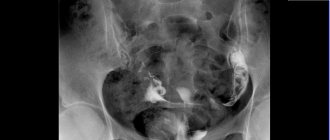Home » Services for women » Gynecology » Treatment of vulvitis in women
Vulvitis is an inflammatory process that affects the external genitalia of girls and women. The symptoms of the disease are unpleasant - pain during sexual intercourse or urination, burning, heavy vaginal discharge, swelling and itching. Often this pathology is caused by improper hygiene and hormonal imbalances.
Vulvitis in women with timely started therapy practically does not cause complications. If the disease occurs in a girl at an early age, it often provokes the development of a pathology such as fusion of the labia minora.
Vulvovaginitis
Vulvovaginitis is a disease of the female genital organs.
Inflammation may be of bacterial origin or be the result of mechanical irritation of the vulvar and vaginal mucosa. The natural structure of the female body allows us to protect the genitals from microorganisms from the external environment. The vaginal microflora of a healthy woman easily inhibits the growth of opportunistic bacteria that live on the mucous membranes. A decrease in immunity due to stress, intoxication or a viral disease can provoke a surge in the activity of pathogens, resulting in the development of acute vulvovaginitis.
Causes of the disease
Inflammation of the vulva and vagina appears due to the influence of such factors:
- violation of intimate hygiene rules, wearing underwear made of low-quality synthetics
- frequent change of sexual partners without the use of barrier contraception
- diseases of the metabolic system that can affect the vaginal microflora (diabetes mellitus, thyroid problems)
- hormonal imbalances characteristic of puberty and menopause
- taking antibacterial drugs (while taking antibiotics, a fungus like Candida is activated)
- chemotherapy and radiation therapy
- intoxication due to chronic infectious diseases
- mechanical injuries of the vulva and vagina, especially regular ones
The presence of more than two risk factors increases the likelihood of the occurrence of pathology several times.
Allergic vaginitis is also possible. Pathology is diagnosed in the presence of helminths.
Diagnosis of vulvitis
Diagnosis is carried out by a gynecologist as follows:
- Inspection;
- Collection of complaints, medical history;
- Colposcopy (if necessary);
- Lab tests.
To determine which microorganisms provoked the pathological process, bacterioscopy of smears is performed, as well as cultural inoculation with determination of sensitivity to antibiotics. It is also important to identify concomitant diseases that may cause inflammation or affect the body's defense mechanisms.
Vulvovaginitis: symptoms
Symptoms do not depend on the cause of the disease. Signs of an inflammatory process in the vulva and vaginal mucosa:
- itching
- burning
- painful sensations in the area of the external genitalia, aggravated by walking
- pain during intercourse
- scanty purulent discharge from the vagina (with mechanical damage to the mucous membrane, it can be abundant)
- increase in body temperature
Little girls may experience neurotic manifestations: sleep disturbance, increased excitability, tearfulness.
The disease can be acute or chronic. Symptoms of the forms of pathology differ only in the degree of severity.
Vulvitis - symptoms and treatment
Success in the treatment of vulvovaginitis depends on an accurate diagnosis based on a thorough analysis of the anamnesis, clinical and laboratory data. Only after receiving the results of bacteriological, virological and histological studies confirming the diagnosis can therapy begin.
First of all, an anti-infective drug , taking into account the sensitivity and type of microorganism.
- For candidiasis - antimycotic drugs, such as Diflucan, fluconazole, nystatin, levorin, clotrimazole, ketoconazole, etc.
- For herpes - antiviral drugs: acyclovir, Valtrex, Famvir.
- For STDs - antibacterial drugs depending on the type of pathogen.
- For bacterial vaginosis - local antiseptics, Clindacin.
- For aerobic vulvovaginitis - local antiseptics, antibiotics taking into account culture indicators.
Treatment of patients with prolonged vulvitis is carried out jointly with dermatologists. In such cases, you can prescribe the combined local drug Tetraderm. It includes:
- Mometasone is the most powerful glucocorticosteroid (GCS) safe for local use. Has anti-inflammatory, antipruritic and anti-exudative effect.
- Econazole is a modern effective antifungal component with a bactericidal effect. Reduces the synthesis of ergosterol, which regulates the permeability of the cell wall of microorganisms.
- Gentamicin is a broad-spectrum antibacterial component used for topical treatment of primary and secondary bacterial skin infections.
- Dexpanthenol (vitamin B5) is a regenerating component with a metabolic effect. It has a local anti-inflammatory and immune effect, is included in the metabolism of skin cells and restores the damaged stratum corneum.
"Makmiror complex" is an antimicrobial combination agent containing nifuratel and nystatin. The drug does not suppress the growth of lactobacilli, so after a course of therapy, normal vaginal flora is quickly restored.
Antimicrobial therapy destroys not only pathogenic, but also beneficial microflora. As a result, more virulent infections invade and colonize the vagina, which again manifests itself as pathological vaginal discharge and vulvar irritation. To break this vicious circle, after antimicrobial therapy it is necessary to restore the flora with eubiotics - preparations containing live cultures of beneficial microorganisms. For example, you can use Laktozhinal. This drug helps normalize the pH of the vaginal microflora due to the production of lactic acid. It consists of :
- Lactobacilli LCR 35 - form a protective film, normalize the pH of the vagina, and prevent the attachment of pathogens. As a result, the stability of the microflora is restored until the moment when the biotope is filled with its own lactobacilli.
- Lactose monohydrate is a nutrient medium for lactobacilli LCR 35. Secreted metabolites by LCR 35 enhance the antibacterial effect.
Application:
- 1 drop per day (No. 21) for vulvovaginal candidiasis;
- 2 drops per day (No. 7) for bacterial vaginosis;
- 1 drop per day (No. 14) as an alternative therapy [10].
Eubiotics also include suppositories “Acilact”, “Lactonorm”, “Triozhinal”, etc.
Proteolytic enzymes enhance the effect of antibiotics . They help accelerate proliferative processes in tissues, activate cellular reactions, enhance the phagocytic activity of leukocytes, and reduce relapses of the disease. Proteolytic enzymes are contained in the Wobenzym preparation. It is resistant to gastric juice. This product contains: bromelain, papain, pancreatin, chymotrypsin, amylase, lipase, rutin. Prescribe 3 tablets 3 times a day for 1-2 months [6]. (The drug should be regarded as a dietary supplement, the effectiveness of which has not been fully proven. - Ed.)
, vitamin therapy, immunostimulants, and interferon inducers are also used [7] .
Due to the fact that prolonged itching is associated with excessive production of histamine, it is recommended to prescribe antihistamines : Suprastin, Tavegil, Diazolin, Zodak, etc. [7]. Some patients with prolonged itching do not consult doctors for a long time and try to treat themselves. As a rule, this does not help, and women go to the doctor with an already formed “vicious circle”. Such patients are recommended to be prescribed sedatives that have a calming effect [2].
Local application of estrogens restores vaginal acidity and neutralizes microbiological changes, especially during menopause, when the level of female sex hormones drops. Also helps prevent recurrences of urinary tract infections.
Vaginal use of estriol preparations reduces vaginal dryness, itching and dyspareunia (pain during sexual intercourse), and significantly improves cytological data. Estriol is a natural estrogen. He is the safest. Has no effect on the endometrium and mammary glands. Estriol contains drugs such as “Ovestin” (cream and suppositories), “Orniona” (cream), etc. For the treatment of vulvar dystrophy, estriol is used in a single dose for 2-3 weeks daily, then a maintenance dose is recommended 1-2 times a week. Moreover, only a small part of a single dose is applied directly to the vulva, and the rest must be inserted into the vagina.
It is important to understand that local estrogen deficiency is possible not only in postmenopausal women, but also in young patients with regular menstruation, therefore, with dyspareunia and recurrent vulvovaginitis, it is important to pay attention to the cytological conclusion, the results of colposcopy and keep in mind possible estrogen deficiency.
Local use of glucocorticosteroids is especially indicated for autoimmune inflammatory dermatosis. Corticosteroids have an anti-inflammatory effect and an antihyperplastic effect on the proliferating superficial layers of the skin. They have antiallergic, local analgesic, antipruritic effects. Because of the risk of scar tissue, corticosteroids are not used long-term, but may be prescribed for a short period to quickly relieve severe itching and pain in the vulva. Corticosteroids are especially effective in cases of severe inflammatory reaction and mainly in patients with lichen sclerosus [5].
Local application of androgens. It is a promising method for the treatment of vulvitis against the background of lichen sclerosus. 2% testosterone propionate in a small amount should be rubbed into the skin 2-3 times a day for 6-8 weeks. Maintenance course - 1 time every other day. However, the drug may cause side effects, the patient must be warned about this. Long-term use of testosterone can lead to clitoromegaly (abnormal enlargement of the outer part of the clitoris), increased sexual desire and facial hair growth [5].
The following surgical treatments are used: cryodestruction, radiofrequency and laser coagulation, vulvectomy. However, due to frequent postoperative complications and relapses, unsatisfactory cosmetic and functional results, these methods are abandoned in favor of less traumatic ones.
Photodynamic therapy is a high-tech method for treating vulvar dystrophy [11]. PDT is an organ-preserving treatment method. A photosensitizer is first introduced into the patient's body, which subsequently accumulates in pathological tissues (malignant, inflammatory, infected with viruses). Further, under the influence of radiation of a certain wavelength, these altered tissues are destroyed. In this case, there is minimal damage to healthy tissue, an antiviral effect, rapid tissue healing and good cosmetic results.
If the result is not satisfactory, the procedure can be repeated. At the end of treatment, the doctor can see a good cosmetic effect, an improvement in the cytological and morphological picture. The woman herself, as a rule, notes a decrease in itching, burning, soreness, dryness, increased tissue elasticity, and an improved quality of sexual life.
When performing photodynamic therapy, the patient must:
- During the day, observe the light regime - avoid exposure to direct sunlight.
- Treat the external genitalia with an antiseptic solution after each act of urination.
- If pain occurs, apply a local anesthetic (for example, Acriol Pro) to the vulvar tissue.
- Apply Tetraderm cream in a thin layer to the vulva from the second day until the tissue is completely epithelized.
- Apply Orniona cream daily at night for a long time.
- See a specialist [11].
Vulvovaginitis: drugs
Local and oral agents are used for treatment.
Vaginal suppositories and creams (Gynex, Clotrimazole, Lomixin) are indicated as local ones. Doctors also prescribe a course of tablet antibiotics (Pancef, etc.). For candidal etiology, antifungal agents are prescribed: Nystatin, Fluconazole, Itraconazole, Metronidazole.
Upon completion of treatment, doctors recommend taking probiotics (Lactozhinal, etc.) to restore the microflora.
If the cause of the disease is worms, anthelmintic drugs are needed: Aldazole, Pirantel.
Atrophic vulvitis during menopause
Lack of estrogen can lead to irritation, dry skin and mucous membranes. This is exactly what happens to the vulva during menopause. To treat atrophic vulvitis, local estrogen preparations and hormone replacement therapy are used.
Uncontrolled use of antibiotics and corticosteroids causes candidiasis of the vagina and vulva. You should strictly follow the doctor’s instructions and not self-medicate. If you experience side effects of treatment or allergies to medications, consult your doctor immediately.
Preventive measures
It is easier to prevent any disease than to treat it. To prevent vulvovaginitis, the following measures are recommended:
- proper toilet of the vulva. You need to wash from front to back. Do not use products with an aggressive pH environment;
- wearing tailored underwear made from natural materials;
- use of barrier contraception;
- excluding douching without indications - this way you can wash healthy flora;
- visit a gynecologist for consultation 1-2 times a year.
Treatment of the disease
Treatment of vulvitis is complex. It is important not only to eliminate the clinical manifestations of the disease, but also the root cause. Adult patients are advised to abstain from sexual activity until the inflammatory process subsides.
Medicines are selected taking into account the etiology of the disease. For allergic vulvitis, histamines are prescribed to reduce the severity of the reaction. It is recommended to use new generation products that do not cause drowsiness. To relieve itching, an ointment or cream with a soothing effect is prescribed.
Bacterial vulvitis is treated with antibiotics. Drugs for external use are prescribed, including miramistin, chlorhexidine, povidone-iodine. For local treatment, lotions with solutions of eucalyptus or furatsilin, medicinal baths with a decoction of calendula, chamomile, and string can also be used. Some doctors recommend antibacterial suppositories and douching with antiseptic drugs.
For candidal vulvitis, antimicrobial agents are prescribed. During treatment, it is advisable to avoid using soap that is aggressive to the mucous membrane: it is better to choose soft gels for intimate hygiene. Candidiasis vulvitis during pregnancy requires mandatory consultation with a personal gynecologist.
For atrophic vulvitis, pills and other means of hormone replacement therapy are used. They are prescribed in a short course. Tablets are not taken chronically.
In the ulcerative form, treatment of vulvitis often requires surgical intervention. During the operation, the pathological focus is removed and plastic surgery is performed.
There is a myth that vulvitis occurs not only in women, but also in men. This is an incorrect name: most often the inflammatory process is confused with candidiasis. This is the name for a fungal disease transmitted through sexual intercourse (which is why in some literature you can find the term “marital” candidiasis). Vulvitis is not sexually transmitted. But if the spouse is diagnosed with candidiasis, there is a risk of infecting the partner.
What complications can there be?
Untreated vulvovaginitis can lead to serious consequences. In girls, the formation of dense adhesions of the labia minora is possible. Such a deformation will make sexual life difficult. In addition, this pathology is one of the factors that provoke cystitis.
The disease is especially dangerous during pregnancy. The expectant mother is at risk of spontaneous abortion, endometritis, or the birth of an infected baby.
Chronic vulvovaginitis leads to hardening of the mucous membranes. With this course, cracks and erosions occur more often, and prerequisites for the appearance of oncology appear.
Possible complications and danger of the disease
Untimely or improper treatment of vulvitis/vulvovaginitis can cause the disease to become chronic. It is characterized by periodic exacerbations, difficulty in therapy, and hypertrophy of the sebaceous glands may occur. Girls may experience synechiae, which sometimes requires surgical intervention.
Vulvovaginitis can cause diseases of the urinary system, cervix, pelvic organs - adnexitis, endometritis, etc., as well as associated infertility.
Popular questions about vulvovaginitis
How to diagnose vulvovaginitis yourself?
The first signs of inflammation are itching, burning and pain in the genital area. These symptoms mean you need laboratory testing to determine the type of pathogen. This is the only way the treatment will be effective.
How often does it occur in children?
Vulvovaginitis occurs quite often in children, because due to age and excessive shyness, girls violate the rules of personal hygiene. In addition, babies often put everything they come across into their mouths, which is why they more often suffer from the helminths that cause this disease.
What complications can there be?
Without treatment, the disease becomes chronic, which can lead to the appearance of an oncological lesion. For girls, there is a high risk of fusion of the labia minora, which is why they may have problems with their sex life in the future.
Types of vulvitis in children
Depending on the timing and severity of the pathology, three forms of the disease are distinguished:
- acute vulvitis in girls - symptoms persist for up to 1 month;
- subacute vulvitis - duration is up to 3 months;
- chronic vulvitis - all inflammatory conditions whose symptoms persist for more than 3 months.
Chronic and subacute vulvitis in girls of preschool age, caused by nonspecific pathogens, are considered common.









